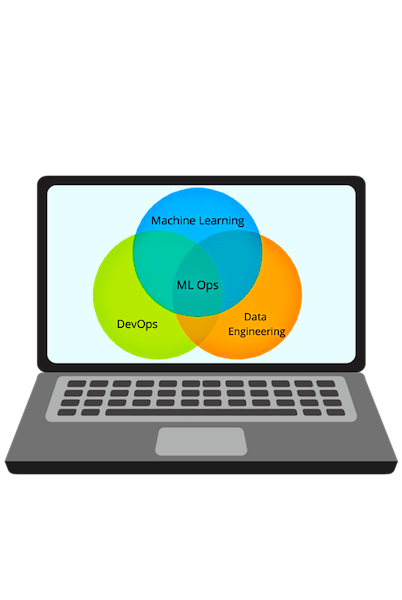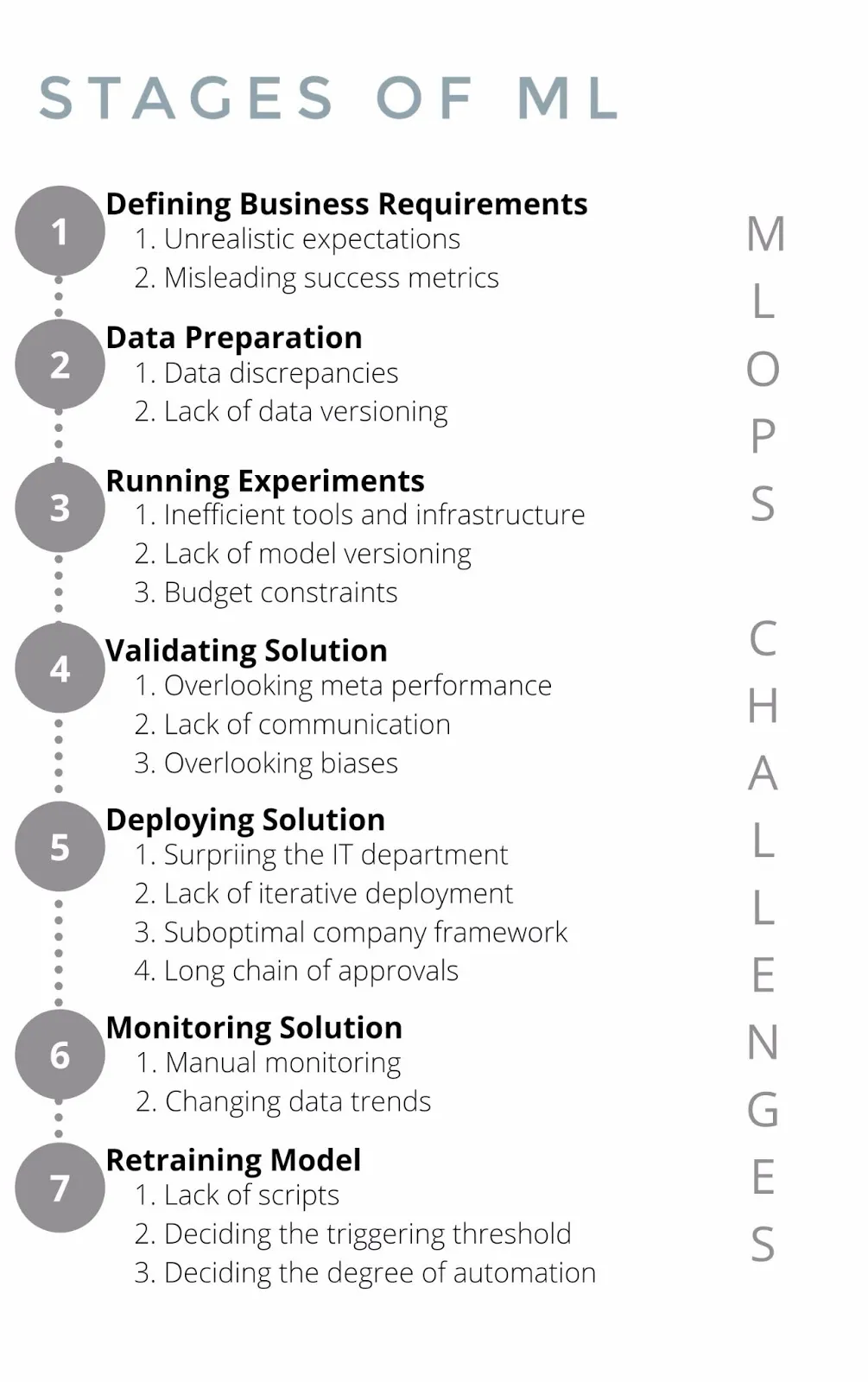



Background
The practices and technology of Machine Learning Operations (MLOps) offer a managed, scalable means to deploy and monitor machine learning models within production environments. MLOps best practices allow businesses to successfully run AI.
MLOps is modeled on DevOps, the existing practice of more efficiently writing, deploying, and managing enterprise applications. DevOps began as a way to unite software developers (the Devs) and IT operations teams (the Ops), destroying data silos and enabling better collaboration.
What is MLOps?
MLOps, or Machine Learning Operations , is the practice of combining machine learning and software engineering best practices in order to improve the speed, quality, and reliability of machine learning models in production. It aims to bring together data scientists and IT professionals in order to streamline the process of building, deploying, and maintaining machine learning models in production environments.
Why is MLOps important?
As machine learning becomes increasingly prevalent in industry, it is important to have a structured and efficient process for deploying and maintaining machine learning models in production. MLOps helps to ensure that machine learning models are reliable, scalable, and can be easily updated and maintained.
MLOps also helps to bridge the gap between data scientists and IT professionals, allowing them to work together more effectively and efficiently. This is especially important as machine learning models often require infrastructure and resources that are managed by IT professionals, and data scientists may not have the necessary expertise in these areas.
What are the key components of MLOps?

There are several key components of MLOps, including:
- Version control:
Using version control systems (such as Git) to track changes to machine learning models and code. This allows teams to easily collaborate on projects, roll back changes if necessary, and ensure that models are reproducible.
- Continuous integration and delivery (CI/CD):
Automating the process of building, testing, and deploying machine learning models. This allows teams to quickly and consistently update models in production environments.
- Infrastructure as code:
Using code (such as Python or Terraform) to automate the provisioning and management of infrastructure resources, such as compute clusters and storage systems. This allows teams to easily scale resources up or down as needed, and ensure that infrastructure is consistent and reproducible.
- Monitoring and testing:
Using monitoring tools (such as Grafana or Prometheus) to track the performance and accuracy of machine learning models in production. This allows teams to quickly detect and fix issues, and ensure that models are performing as expected.
- Collaboration and communication:
Ensuring that all team members are able to collaborate and communicate effectively, whether through tools such as Slack or through more traditional methods such as meetings and email.
What are the benefits of MLOps?
There are several benefits to using MLOps, including:
- Faster model development and deployment:
By automating the process of building and deploying machine learning models, teams can get models into production faster and with fewer errors.
- Improved model reliability and scalability:
By using monitoring and testing tools, teams can ensure that models are performing as expected and are able to scale to meet increasing demand.
- Easier model maintenance:
By using version control and infrastructure as code, teams can easily update and maintain models over time, ensuring that they remain accurate and reliable.
Enhanced collaboration and communication: By bringing data scientists and IT professionals together and establishing clear processes for communication and collaboration, MLOps helps teams to work more effectively and efficiently.
What are some challenges with MLOps?
While MLOps has many benefits, there are also challenges that teams may face when implementing it. These challenges include:
- Lack of resources:
MLOps requires a significant investment of time and resources in order to be implemented effectively. This can be a challenge for teams that are already stretched thin or do not have the necessary expertise.
- Complexity:
Machine learning models can be complex and difficult to understand, which can make it challenging to implement and maintain them in production environments.
- Lack of standardization: '
There is currently no one “right” way to implement MLOps, and different teams may have different approaches and tools that they use. This can make it difficult for teams to work together and share best practices.
- Data privacy and security:
Machine learning models often work with sensitive data, which can present challenges in terms of data privacy and security. Teams must ensure that data is handled properly and that models are secure in order to protect sensitive information.
- Integration with existing processes and systems:
MLOps must be integrated with existing processes and systems in order to be effective. This can be a challenge if teams are using different tools and systems, or if there is a lack of integration between different parts of the organization.
Companies using MLOPS
There are many companies across a wide range of industries that are using MLOps to improve the speed, quality, and reliability of their machine learning models in production. Some examples of companies that are using MLOps include:
- Google:
Google has implemented MLOps practices across its various products and services, including search, advertising, and cloud services.
- Netflix:
Netflix uses MLOps to improve the recommendation algorithms that power its streaming platform, as well as to optimize its content delivery network.
- Uber:
Uber uses MLOps to improve the accuracy and efficiency of its algorithms, which are used for tasks such as predicting demand for rides and optimizing routes for drivers.
- Airbnb:
Airbnb uses MLOps to improve the accuracy of its machine learning models, which are used for tasks such as predicting demand for rental properties and recommending listings to users.
- Facebook:
Facebook uses MLOps to improve the performance and reliability of its machine learning models, which are used for tasks such as identifying spam and detecting fake news.
These are just a few examples of companies that are using MLOps. Many other companies across a wide range of industries are also adopting MLOps practices in order to improve the performance and reliability of their machine learning models.
Journey of MLOPS
The journey of MLOps involves implementing a set of practices and tools that allow teams to build, deploy, and maintain machine learning models in production environments. Here is a high-level overview of the journey of MLOps:
➼ 1. Define the objectives and goals of the MLOps project:
Before starting the MLOps journey, it is important to clearly define the objectives and goals of the project. This may include identifying the specific business problems that the machine learning models will be used to solve, as well as any constraints or requirements that must be considered.
➼ 2. Assemble the MLOps team:
MLOps requires collaboration between data scientists and IT professionals, so it is important to assemble a team that has the necessary expertise and skills. This team should include data scientists who are responsible for building and training the machine learning models, as well as IT professionals who are responsible for deploying and maintaining the models in production environments.
➼ 3. Establish a version control system:
In order to track changes to machine learning models and code, it is important to establish a version control system such as Git. This allows teams to easily collaborate on projects, roll back changes if necessary, and ensure that models are reproducible.
➼ 4. Implement continuous integration and delivery (CI/CD):
CI/CD involves automating the process of building, testing, and deploying machine learning models. This allows teams to quickly and consistently update models in production environments, and helps to reduce the risk of errors or issues.
➼ 5. Use infrastructure as code:
Infrastructure as code involves using code (such as Python or Terraform) to automate the provisioning and management of infrastructure resources, such as compute clusters and storage systems. This allows teams to easily scale resources up or down as needed, and ensures that infrastructure is consistent and reproducible.
➼ 6. Implement monitoring and testing:
Monitoring and testing tools (such as Grafana or Prometheus) can be used to track the performance and accuracy of machine learning models in production. This allows teams to quickly detect and fix issues, and ensures that models are performing as expected.
➼ 7. Establish clear collaboration and communication channels:
MLOps requires effective collaboration and communication between data scientists and IT professionals. It is important to establish clear channels for communication, such as Slack or regular meetings, in order to ensure that all team members are able to work together effectively.
➼ 8. Iterate and improve:
The journey of MLOps is ongoing, and teams should continually iterate and improve their processes and tools in order to stay current and optimize performance. This may involve updating models as new data becomes available, experimenting with different tools and techniques, or adjusting the team’s approach to MLOps.
MLOps challenges and potential solutions

There is a very good blog post by Neptune AI for these challenges , please refer the blog here MLOps challenges and potential solutions
